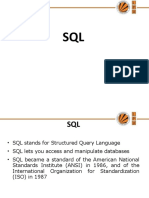0% found this document useful (0 votes)
7 views10 pagesSQL Notes
SQL, or Structured Query Language, is a standard language used for managing and manipulating data in relational databases. The document outlines the history of SQL, its features, commands, data types, and operations, along with examples of SQL syntax for various database tasks. It also covers SQL constraints, NULL values, and indexing for efficient data retrieval.
Uploaded by
salmansks44Copyright
© © All Rights Reserved
We take content rights seriously. If you suspect this is your content, claim it here.
Available Formats
Download as DOCX, PDF, TXT or read online on Scribd
0% found this document useful (0 votes)
7 views10 pagesSQL Notes
SQL, or Structured Query Language, is a standard language used for managing and manipulating data in relational databases. The document outlines the history of SQL, its features, commands, data types, and operations, along with examples of SQL syntax for various database tasks. It also covers SQL constraints, NULL values, and indexing for efficient data retrieval.
Uploaded by
salmansks44Copyright
© © All Rights Reserved
We take content rights seriously. If you suspect this is your content, claim it here.
Available Formats
Download as DOCX, PDF, TXT or read online on Scribd
/ 10






















































































